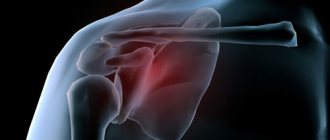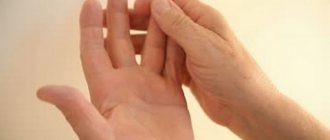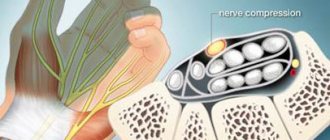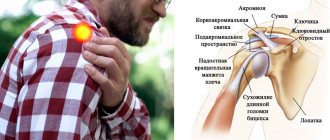Pain under the shoulder blade
- a fairly typical localization of back pain, although it is much less common than, for example, lower back pain. The scapula is a flat bone, approximately triangular in shape, adjacent to the back of the chest in the area from the 2nd to the 8th rib. The shoulder blades tend to protrude slightly, forming the relief of the back, so we all know where they are and describe pain in relation to the shoulder blade if we feel it in the upper back to the right or left of the spine.
Pain in the shoulder blade area can be caused by various reasons. A simple indication of what hurts under the shoulder blade is not enough to determine what caused the pain, which means you cannot self-medicate without visiting a doctor and establishing the nature of the disease. At the same time, pain under the shoulder blade can be caused by very serious diseases, so if you experience severe or recurring pain under the shoulder blade, you should definitely consult a doctor. Don't expect the problem to go away on its own.
If you have pain under the shoulder blade, you need to pay attention to other symptoms, this will help the doctor make a diagnosis.
Causes of pain between the shoulder blades
In some cases, the patient complains that he has pain between the shoulder blades. Such localization is typical, first of all, for diseases of the thoracic spine - osteochondrosis, scoliosis, kyphosis, spondyloarthrosis, intervertebral hernia, protrusion of the intervertebral disc. Also, pain between the shoulder blades can be observed with coronary heart disease, intercostal neuralgia, and gastrointestinal diseases.
The causes of pain that cause pain under the right or under the left shoulder blade are different.
Types of pain
The following types of pain exist:
- reflected. It can be aching, deep, burning or dull, and is often combined with other symptoms. This type of pain is caused by diseases of the internal organs;
- somatic. It can be diffuse in nature, can be acute, aching, dull and responds adequately to the use of analgesics. Occurs in or near the affected area. The cause is diseases of the spine, bones, tendons;
- irradiating. The pain is acute, intense, accompanied by motor disturbances and does not respond to analgesics. This type of pain syndrome occurs as a result of disturbances in the functioning of the nervous system;
- dysfunctional. Pain sensations can occur in different places, as a result of malfunctions of the central nervous system, namely the areas responsible for susceptibility.
The nature of the pain can be: sharp, dull, pulling, burning, aching. In the chronic form of the disease, pain syndrome can be observed for a long period with moments of exacerbation and remission.
Causes of pain under the left shoulder blade
Pain under the left shoulder blade can be due to the following reasons:
- incorrect position while sleeping. In this case, a person wakes up with pain under the left shoulder blade and in the left shoulder. This pain usually goes away quite quickly;
- stomach ulcer. Peptic ulcer is a fairly common cause of pain under the left shoulder blade. In this case, the pain, as a rule, is aching in nature, gradually increasing, accompanied by gagging, heartburn and belching. After vomiting there is usually relief. As a rule, with a peptic ulcer, the onset of pain is associated with food intake;
- stress, panic and other psychological reasons. Psychogenic pain is described as congestion, compression, heaviness; may be accompanied by fever or a tingling sensation. Sometimes dizziness or a feeling of a lump in the throat is added. In this case, the pain is localized in the chest, and radiates under the left shoulder blade (people say “gives away”). The pain can spread wider, involving the shoulder blade itself, the neck, turning into a headache;
- heart diseases such as myocarditis, angina pectoris, myocardial infarction. A heart problem is very likely if there is pain both under the left shoulder blade and behind the sternum;
- osteochondrosis. With osteochondrosis, pain often occurs in the morning, that is, a person wakes up with pain. Patients in this case often say that the pain under the shoulder blade radiates to the arm or head;
- intercostal neuralgia;
- inflammatory lung diseases, in particular pneumonia.
This list contains the most common causes; the full list of causes of pain under the left shoulder blade is much longer.
Musculoskeletal system
Pathologies of the musculoskeletal system are provoked by various injuries:
Why does my upper back hurt?
- fractures and cracks caused by impacts, falls, road accidents, etc. The aching pain intensifies when a person makes movements. Also, the damaged area swells, a bruise appears, and mobility decreases;
- dislocations, which are observed in rare cases and occur when there is a strong pull on the arm or a blow to the shoulder blade. In this case, the bone rotates, shifts, and takes on an abnormal position. Its lower edge is compressed between the ribs.
The muscles connecting the scapula and spine are subject to excessive stress, causing stretching and possible rupture.
Pain in the area of the left shoulder blade on the back caused by injury occurs immediately after the injury and only goes away as the patient recovers.
In addition to injuries, pain in the area of the shoulder blade from the back is often caused by diseases of the musculoskeletal system.
Pain syndrome under the scapula, which is a consequence of cervical osteochondrosis (dystrophic-degenerative processes in the intervertebral discs of the spine), is spontaneous and can be aching and pulling. Increased pain is observed when a person remains in a sitting position for a long time and during physical exertion. Taking medications does not bring relief.
A pinched, inflamed intercostal nerve causes unbearable pain in the sternum, in the area where it lies. The syndrome intensifies as a person moves, when he coughs, sneezes, inhales deeply, and changes body position. Constant or paroxysmal pain syndrome is sharp, strong, shooting in nature. Sometimes pain manifests itself in the heart area, in the lower back, and affects the neck and arms. It can also affect the shoulder blade.
Manifestations of intercostal neuralgia are similar to symptoms caused by cardiac problems, cholecystitis, angina pectoris, and pleurisy. Only a qualified specialist can make a correct diagnosis
When there is inflammation in the shoulder tendon and capsule of the shoulder joint without damage to the joint and cartilage itself (humeral periarthritis), pain affects the shoulder joint, sometimes the area between the shoulder blades and the bone itself. They are sharp and intensified at night. The disease is accompanied by slight swelling of the shoulder, elevated temperature in the range of 37–37.4ºС, and limited circular movements of the shoulder. The pathology is widespread and is diagnosed as a consequence of injuries, bruises, and increased loads on the shoulder joint.
With inflammation of the cervical muscles (myositis), caused by overstrain or infection, severe pain affects the entire cervical-brachial region, radiating to the scapula, occipital region, and arms.
Muscle pain in the scapula area occurs due to physical strain or impact on the bone.
Pain due to malignant lesions of the bone structure or soft tissues refers to the initial manifestation of the disease. At first, they do not differ in intensity and appear periodically, which makes timely diagnosis difficult. The development of pathological processes leads to an increase in the severity of negative sensations that haunt a person even at rest, mainly at night. Not eliminated by non-narcotic analgesics. Next, the bone becomes deformed, the surrounding tissues swell, the skin over the malignant focus changes, and fractures occur that are not associated with trauma.
In the presence of an inflammatory process in the bone (osteomyelitis) caused by streptococci, staphylococcus, salmonella, E. coli and other infectious agents, the patient is exposed to high fever, chills, and increased heart rate. There are complaints of back pain in the scapula and muscles, which decrease when the abscess is opened.
Please note! Painful manifestations under or above the left shoulder blade and in the bone area are inherent in congenital anomalies. These include aplasia (absence of an organ), hypoplasia (insufficient bone development), pterygoid scapula, and Sprengel's disease. At the same time, a person often suffers from cosmetic defects and limited motor activity.
Intervertebral hernia and protrusion of the discs of the cervical spine lead to compression of the nerve roots by bone formations, which causes pain when moving, especially when tilting the head.
Causes of pain under the right shoulder blade
The most common causes of pain under the right shoulder blade are:
- problems of the biliary system. Acute pain under the right shoulder blade can be observed with acute cholecystitis or cholelithiasis. The usual localization of pain in this case is in the right hypochondrium. The pain may radiate to the scapula or right shoulder. Associated symptoms are a bitter taste in the mouth, heartburn, nausea, vomiting;
- kidney diseases – nephritis, pyelonephritis. In this case, pain under the right shoulder blade is usually accompanied by pain in the lumbar region;
- liver diseases. The liver is located in close proximity to the right shoulder blade, and liver problems often lead to pain in this area;
- coronary heart disease (angina pectoris, myocardial infarction);
- osteochondrosis.
Also, pain under the right shoulder blade can be caused by other reasons, among which there are very dangerous diseases - aortic aneurysm, appendicitis and some others.
Heart and blood vessels
Back pain below the left shoulder blade is often the result of problems in the cardiovascular system.
Substernal pain in the central part or to the left, with extension to the upper part of the body, signals myocardial infarction. At the same time, a strong burning sensation may be observed under the left shoulder blade from the back. It is impossible to clearly characterize the pain syndrome. It can be aching, or it can manifest itself in an acute form.
Lack of blood supply to the myocardium causes an attack of angina, characterized by pressing or squeezing retrosternal pain, often radiating to the left shoulder blade, arm, and lower jaw. At the same time, blood pressure may increase, sweating and pallor may appear.
Angina attacks usually occur in stressful situations or from increased physical activity. They are treated with nitroglycerin. When the duration of pain exceeds 20 minutes or medications do not provide relief, the presence of myocardial infarction can be assumed.
High blood pressure or atherosclerotic lesions lead to aneurysm (enlargement) or dissection of the aorta (incomplete rupture or tear of the endothelium with subsequent spread of blood between the layers of the vessel wall).
Small aneurysms do not manifest themselves in any way. As they increase, a person begins to feel a dull pain in the back. A dissecting aneurysm is characterized by a pronounced clinical picture. When a tear occurs, the pain sensation is sharp and short-lived. It affects the chest and back, leading to a reflex decrease in blood pressure and fainting. After a certain period of time, a person feels a burning pain in the chest, arms, neck, under the left shoulder blade. The syndrome cannot be eliminated using available medications. In this condition, death is very possible, so urgent medical attention is necessary.
Pain below the left shoulder blade is caused by:
- ischemia – lack of blood supply to the heart;
- pericarditis – inflammatory processes in the pericardium;
- endocarditis - an inflammatory disease of the inner lining of the heart;
- myocarditis – inflammation of the heart muscle.
Disturbances in the autonomic nervous system cause vegetative-vascular dystonia. The disease is characterized by numerous manifestations, including pain under the left shoulder blade, similar to heart pain. In addition, the person suffers from irritability, memory impairment, increased sweating, etc.
Causes of pain between the shoulder blades
In some cases, the patient complains that he has pain between the shoulder blades. Such localization is typical, first of all, for diseases of the thoracic spine - osteochondrosis, scoliosis, kyphosis, spondyloarthrosis, intervertebral hernia, protrusion of the intervertebral disc. Also, pain between the shoulder blades can be observed with coronary heart disease, intercostal neuralgia, and gastrointestinal diseases.
A little anatomy
The scapula is a flat triangular bone adjacent to the chest at the back in the area from the 2nd to 7th ribs. Performs binding, protective, strengthening and motor functions.
The scapula connects the girdle of the upper limbs with the arms and sternum. It protects the shoulder joint and protects the lungs and aorta from mechanical stress. Certain muscles extending from the shoulder blades are designed to strengthen and support the shoulder joints. Thanks to these parts of the skeleton, mobility of the shoulder girdle is ensured; their functions extend even to the lower limbs. The bone is equipped with nerve roots emanating from the cervicothoracic region.
When you need a doctor for pain under the shoulder blade
If the pain under the shoulder blade appeared for the first time and quickly passed, then it was probably associated with an accidental cause - for example, the body was in an uncomfortable position for a long time. If the pain persists, intensifies or causes discomfort (in case of severe pain), you should definitely consult a doctor.
In some cases, emergency medical attention is required. Call an ambulance if:
- pain under the shoulder blade is associated with injury. Especially in the presence of bleeding and signs of bone fracture;
- along with pain, deformation, swelling, edema or redness in this area is observed;
- pain is accompanied by increased heartbeat, difficulty breathing (shortness of breath, feeling of lack of air);
- the pain is accompanied by dizziness and faintness.
Features of disease diagnosis
If the patient feels a dull pain and begins to ache in the area of the left shoulder blade, treatment begins with a full examination. Diagnostics involves the following procedures:
- X-ray of the spine, and it is performed in several projections. The image may also show problems with the lungs.
- CT scan.
- MRI.
- If there are cardiac symptoms, the patient is prescribed an ECG.
- Ultrasound of internal organs.
- Instrumental examination of pulse and blood pressure.
- Biochemical and general blood test
After examination and determination of the cause of the pathological condition, the patient is prescribed treatment. He may also need to consult a cardiologist or gastroenterologist.
Pain under the shoulder blade: which doctor should I contact?
If you complain of pain under the shoulder blade, it is recommended to consult a general practitioner (general practitioner or family doctor). It is the general practitioner who must determine which specialists should be examined.
If the pain under the shoulder blade is associated with eating, accompanied by heartburn, belching, or a feeling of bitterness in the mouth, you will probably need to consult a gastroenterologist.
If there is reason to believe that the pain is related to the spine, for example, if the pain intensifies with movement of the torso or shoulder, then you will be referred to a neurologist, vertebroneurologist or chiropractor.
You must be prepared that you may need to consult a cardiologist or urologist.
General anatomical information
So, if you look at the back from the back, you can see that the left shoulder blade is fixed on the ribs that make up the chest. Between each of them there is a nerve and blood vessels located in the recesses. The ribs are connected to each other by ligaments and muscles.
Closer to the center of the shoulder blade is the spine, inside which the spinal cord is located. All the nerves come from him. The back muscles surrounding the shoulder blade are quite well developed. Its purpose is to protect the left lung, heart, spleen, stomach and pancreas, as well as the thoracic aorta.
Treatment methods
The choice of treatment methods directly depends on the cause of pain. If serious traumatic injuries are excluded, symptoms associated with disorders of the musculoskeletal system are treated using medicinal and non-medicinal therapies:
- Immobilization. If the muscle under the shoulder blade hurts, limiting physical activity allows it to completely rest and the discomfort associated with overexertion disappears.
- Drug treatment. Treatment may include NSAIDs (non-steroidal anti-inflammatory drugs), muscle relaxants and antidepressants. Sometimes patients are prescribed injections of painkillers and hormones, they can take chondroprotectors, etc.
- Physiotherapeutic procedures to reduce inflammation, eliminate back pain and improve regenerative processes.
- Manual therapy. It effectively removes muscle blocks, improves the mobility of motor elements, and helps restore normal functioning of the spinal column and shoulder joints.
In some cases, treatment of pain under the scapula requires surgical intervention.
Surgeons' help may be needed for advanced osteochondrosis and intervertebral hernia, arthritis, frozen shoulder syndrome, etc. Please follow and like us:
Treatment of pain in the shoulder blades
For each of our patients, depending on their condition, treatment is selected individually by the doctor. At the Alan Clinic Center for Neurology and Orthopedics, there is a whole range of methods for this, ranging from time-tested massage and physical therapy to modern techniques.
Of course, we can alleviate your condition, no matter what stage your illness is, but the sooner you do this, the more productive the treatment and speedy recovery will be.
We have at our disposal the following methods:
- Manual therapy;
- Osteopathy - treatment by the hands of a doctor, a gentle effect on the musculoskeletal system, nervous and vascular systems, internal organs;
- Yumeiho therapy;
- Medical massage;
- Acupuncture - exposure to biologically active points with microneedles;
- Laser reflexology is a painless effect on reflexogenic zones and points;
- Tsubotherapy is a gentle effect on the body’s reflex points;
- Pharmacopuncture - the introduction of medicinal drugs of natural origin to the source of the problem;
- Plasma therapy is the introduction of the patient’s own purified blood into the site of the disease;
- Isometric kinesiotherapy - individual gymnastic techniques/exercises, according to indications, with elements of joint massage;
- Kinesiotherapy using the Exart installation;
- Kinesio taping;
- Ozone therapy - treatment with active oxygen;
- Physiotherapy;
- Physiotherapy with enzyme preparations;
- Therapeutic droppers;
- Hirudotherapy - treatment with leeches;
- Botulinum therapy - treatment with botulinum toxin;
- Intra-articular injection of synovial fluid endoprostheses;
- Intra-articular blockades.











